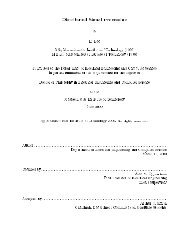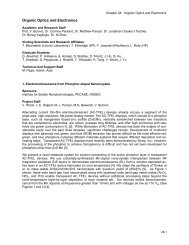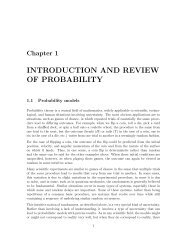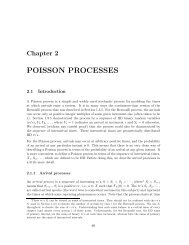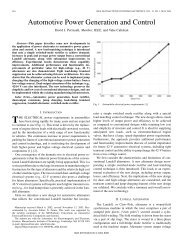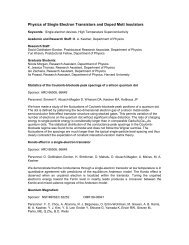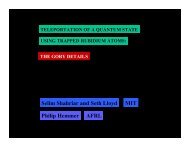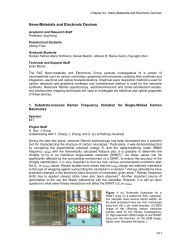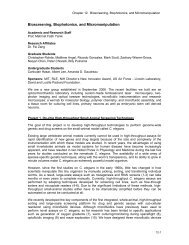A 24 Gb/s Software Programmable Analog Multi-Tone - Research ...
A 24 Gb/s Software Programmable Analog Multi-Tone - Research ...
A 24 Gb/s Software Programmable Analog Multi-Tone - Research ...
Create successful ePaper yourself
Turn your PDF publications into a flip-book with our unique Google optimized e-Paper software.
1008 IEEE JOURNAL OF SOLID-STATE CIRCUITS, VOL. 43, NO. 4, APRIL 2008<br />
[5] V. Stojanović, A. Amirkhany, and M. A. Horowitz, “Optimal linear<br />
precoding with theoretical and practical data rates in high-speed serial-link<br />
backplane communication,” in Proc. IEEE Int. Conf. Communications,<br />
2004, pp. 2799–2806.<br />
[6] A. Amirkhany, A. Abbasfar, V. Stojanović, and M. A. Horowitz, “Practical<br />
limits of multi-tone signaling over high-speed backplane electrical<br />
links,” in Proc. IEEE Int. Conf. Communications, 2007, pp. 2693–2698.<br />
[7] A. Amirkhany, A. Abbasfar, V. Stojanović, and M. A. Horowitz,<br />
“SPC03-5: <strong>Analog</strong> multi-tone signaling for high-speed backplane<br />
electrical links,” in Proc. IEEE GLOBECOM’06, Nov. 2006, pp. 1–6.<br />
[8] A. Amirkhany et al., “ A <strong>24</strong> <strong>Gb</strong>/s aoftware programmable<br />
multi-channel transmitter,” in Symp. VLSI Circuits Dig. Tech. Papers,<br />
2007, pp. 38–39.<br />
[9] A. Amirkhany, V. Stojanović, and M. A. Horowitz, “<strong>Multi</strong>-tone<br />
signaling for high-speed backplane electrical links,” in Proc. IEEE<br />
GLOBECOM’04, Nov.-Dec. 2004, vol. 2, pp. 1111–1117.<br />
[10] S. Sidiropoulos and M. A. Horowitz, “A 700-Mb/s/pin CMOS signaling<br />
interface using current integrating receivers,” IEEE J. Solid-<br />
State Circuits, vol. 35, no. 5, pp. 681–690, May 1997.<br />
[11] P. P. Vaidyanathan, <strong>Multi</strong>rate Systems and Filter Banks. Englewood<br />
Cliffs, NJ: Prentice-Hall, 1993.<br />
[12] S. B. Weinstein and P. M. Ebert, “Data transmission by frequency-division<br />
multiplexing using the discrete Fourier transform,” IEEE Trans.<br />
Commun. Technol., vol. COM-19, no. 10, pp. 628–634, Oct. 1971.<br />
[13] J. Savoj, A. Abbasfar, A. Amirkhany, M. Jeeradit, and B. Garlepp, “A<br />
12- GS/s phase-calibrated CMOS digital-to-analog converter,” in Symp.<br />
VLSI Circuits Dig. Tech. Papers, 2007, pp. 68–69.<br />
[14] M. Nagamatsu, S. Tanaka, J. Mori, K. Hirano, T. Noguchi, and K.<br />
Hatanaka, “A 15-ns 32 2 32-b CMOS multiplier with an improved<br />
parallel structure,” IEEE J. Solid-State Circuits, vol. 25, no. 2, pp.<br />
494–497, Apr. 1990.<br />
[15] W. Beyene, “Controlled inter-symbol interference design techniques<br />
of conventional interconnect systems for data rates beyond 20 <strong>Gb</strong>ps,”<br />
Electr. Perform. Electron. Packag., pp. 159–162, Oct. 2006.<br />
[16] A. Amirkhany, A. Abbasfar, J. Savoj, and M. Horowitz, “Time-variant<br />
characterization and compensation of wideband circuits,” in Proc.<br />
IEEE Custom Integrated Circuits Conf. (CICC), Sep. 2007, pp.<br />
487–490.<br />
[17] A. Amirkhany, “<strong>Multi</strong>-carrier signaling for high-speed electrical links,”<br />
Ph.D. dissertation, Stanford Univ., Stanford, CA, Mar. 2007 [Online].<br />
Available: http://mos.stanford.edu/group/people.html<br />
Aliazam Abbasfar (S’01–M’05–SM’07) received<br />
the B.Sc. and M.Sc. degrees from the University<br />
of Tehran, Tehran, Iran, in 1992 and 1995, respectively,<br />
and the Ph.D. degree from the University of<br />
California, Los Angeles (UCLA), in 2005, all in<br />
electrical engineering.<br />
Upon graduation from UCLA, he joined Rambus<br />
Inc., Los Altos, CA, where he is involved with<br />
high-speed data communications on wireline backplane<br />
links. From 1992 to 1994, he was with the Iran<br />
Telecommunication <strong>Research</strong> Center (ITRC), where<br />
he was involved with switching networks for data communications. Between<br />
2001 and 2004, he held positions as a Senior Design Engineer in the areas of<br />
communication system design and digital VLSI ASIC design with Innovics<br />
Inc., Sequoia Communications, and Jaalaa Inc. His main research interests<br />
include wireless communications, equalization, error correcting codes, and<br />
VLSI ASICs for digital data communications.<br />
Jafar Savoj (S’98–M’02–SM’07) received the<br />
B.Sc. degree in electrical engineering from Sharif<br />
University of Technology, Tehran, Iran, in 1996, and<br />
the M.Sc. and Ph.D. degrees in electrical engineering<br />
from the University of California, Los Angeles, in<br />
1998 and 2001, respectively.<br />
He is currently with the Core Technology Group,<br />
Rambus, Los Altos, CA. Prior to that, he held positions<br />
with Transpectrum and Marvell.<br />
Dr. Savoj was a recipient of a IEEE Solid-State<br />
Circuits Society Predoctoral Fellowship for<br />
2000–2001, the Beatrice Winner Award for Editorial Excellence at the 2001<br />
ISSCC, and the Design Contest Award of the 2001 Design Automation Conference.<br />
He is with the technical program committee of the IEEE Symposium on<br />
VLSI Circuits. He served as a technical program committee member and most<br />
recently as the chair of the wired committee of the IEEE Custom Integrated<br />
Circuits Conference (CICC) until 2007. He was a Guest Editor for the IEEE<br />
JOURNAL OF SOLID-STATE CIRCUITS in 2005 and 2006.<br />
Metha Jeeradit (S’02) received the B.S. and M.Eng.<br />
degrees in electrical and computer engineering degrees<br />
from Cornell University, Ithaca, NY, in 2001<br />
and 2002, respectively. In 2002, he started his Ph.D.<br />
program in electrical engineering with Stanford University,<br />
Stanford, CA.<br />
In 2004, he joined Rambus Inc., Los Altos, CA.<br />
His main research interests include PLLs and circuit<br />
optimizations.<br />
Amir Amirkhany (S’04–M’08) received the M.Sc.<br />
degree from the University of California, Los Angeles,<br />
in 2002, and the B.Sc. degree from Sharif University<br />
of Technology, Tehran, Iran, in 1999, both in<br />
electrical engineering. He is currently pursuing the<br />
Ph.D. degree in electrical engineering from Stanford<br />
University, Stanford, CA.<br />
Since July 2007, he has been with Rambus Inc.,<br />
Los Altos, CA. Since 2003, he has been a <strong>Research</strong><br />
Assistant with the VLSI Group, Stanford University,<br />
and in close collaboration with Rambus Inc., where<br />
he has been involved with the design of chip-to-chip electrical links. Prior to<br />
Stanford, he was with Sequoia Communications, working on the ASIC design<br />
of WCDMA systems. His main research interests include the design and implementation<br />
of communication systems, VLSI circuit design, and application<br />
of communication and signal processing techniques to the design of low power<br />
circuits.<br />
Mr. Amirkhany was a recipient of a Best Student Paper Award at the IEEE<br />
Global Communications Conference in 2006 for his work on the design and<br />
analysis of an analog multi-tone system for chip-to-chip interconnects.<br />
Bruno W. Garlepp (M’97) was born in Bahia,<br />
Brazil, in 1970. He received the B.S.E.E. degree<br />
from the University of California, Los Angeles,<br />
in 1993, and the M.S.E.E. degree from Stanford<br />
University, Stanford, CA, in 1995.<br />
In 2007, he joined SiTime Corp., Sunnyvale,<br />
CA, as Director of Circuit Engineering to lead the<br />
design of synthesizer and timing ICs based on silicon<br />
MEMS resonators. In 1993, he joined the Hughes<br />
Aircraft Advanced Circuits Technology Center,<br />
Torrance, CA, where he designed high-precision<br />
analog ICs for A/D applications and RF circuits for wide-band communication<br />
applications. In 1996, he joined Rambus Inc., Mountain view, CA, where<br />
he designed high-speed CMOS clocking and I/O circuits for synchronous<br />
chip-to-chip interfaces. In 2000, he joined Silicon Laboratories, Austin, TX,<br />
where he designed high-performance CDR and clock synthesis ICs for SONET<br />
applications. In 2003, he returned to Rambus Inc., Los Altos, CA, where he<br />
designed multi-gigahertz signaling interfaces for serial data communications<br />
and led a team investigating multi-tone techniques for multi-gigahertz serial<br />
links.



